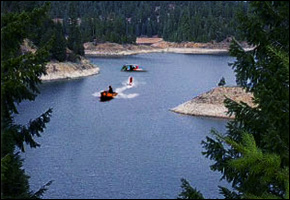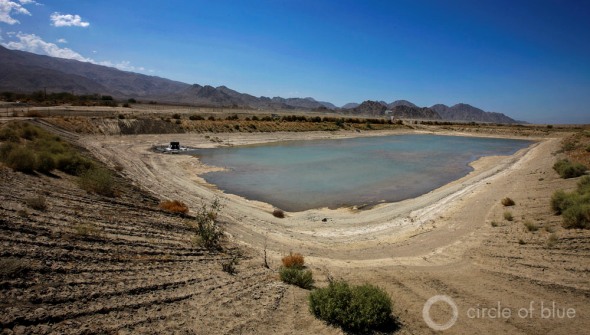Business, Finance Leaders Address U.S. Water Policy
From markets and higher prices, better water systems will flow, they say.
Three years ago the U.S. Environmental Protection Agency asked a big question: What is the value of water to the American economy?
After two years of meetings and multiple studies, the results were conclusive in the all the wrong ways.
Water was clearly valuable – energy production, drinking water supply, and agriculture account for 94 percent of U.S. water withdrawals – but the numbers necessary for the sort of detailed evaluations that policy wonks crave were not widely available. Data on water use were absent or incomplete. Even economic signals were off. Prices paid by residents and farmers, both subsidized in different ways, often covered neither the cost of providing water nor reflected water’s worth were it traded on a market.
And true to its nature as a resource that flows and shifts, water’s value changed depending on hydrologic conditions and geographic location. The entire exercise, though helpful in identifying gaps, added up to a case of stating the obvious.
“Reliable information on the economic importance of water is, in many ways, elusive,” asserted the summary report, published in November 2013.
The value of water is again weighing on American minds. When the EPA began its water study in 2011, Texas was in the middle of its hottest, driest year in recorded history. Today, that distinction falls on California, which is enduring its own inferno – the state’s hottest, driest three-year period in more than one century of record keeping.
It is fitting then that Californians – and the nation, as well – should be talking about what water is worth and what uses of it are worthwhile.
That conversation will be given a significant boost on Monday, October 20 at a conference on Stanford University’s campus.
Organized by Stanford’s Woods Institute for the Environment and the Hamilton Project, a Brookings Institution offshoot that is keen on using economic tools to solve policy problems, the one-day conference will highlight the ways that markets and prices can reduce water consumption and catalyze technological innovation that can make better use of scarce supplies. These messages are all the more interesting because of who is delivering them.
Starpower
These meetings usually draw academics and policymakers, and the event has its share of star researchers and public officials: Robert Glennon, professor of law and public policy at the University of Arizona; Peter Gleick, president of the Pacific Institute; James Lochhead, manager of Denver Water; and even Jerry Brown, governor of California.
But this event is notable for who else will be holding the microphone – the titans of business and finance. Sheryl Sandberg, chief operating officer of Facebook, will open the meeting, while Tom Steyer, a hedge-fund billionaire turned climate campaigner, will moderate a session on how global warming is affect water supplies. Former U.S. Treasury Secretary Robert Rubin will also speak.
Though the event adjourns just after the lunch hour, participants say they desire more than collegial chatter – action is the goal.
“The first hope is that this event will lead to policy change,” Barton Thompson, a Stanford University law professor, told Circle of Blue.
Thompson is a co-author on one of the two papers that were commissioned for the conference by the Hamilton Project and are being discussed on Monday.
One paper argues that when water is scarce, markets are needed for two reasons: to encourage conservation, by increasing the price of water, and to move supplies to where they can produce the most economic value. Western U.S. states should facilitate these deals by establishing underground storage facilities that act as banks and by restricting the use of free groundwater.
Thompson’s paper looks at technological innovation. He recommends four policies for spurring investments that will help create sustainable water systems.
First, water suppliers should price water so that it reflects the cost of moving and purifying water as well as the cost of repairing and replacing the pipes, pumps, and treatment facilities involved in the process. Seemingly a common sense business principle, many utilities are nonetheless failing at this basic financial duty. Only one-third of utilities earn enough revenue to maintain a financially stable operation that accounts for both current operations and future maintenance, according to a survey of utility managers conducted by Black & Veatch, an engineering firm. It should be no surprise then that U.S. water utilities are behind on infrastructure investment.
The second recommendation is a partial remedy for the funding gap. Utilities should levy an extra fee on customer water bills, called a public goods charge, Thompson argues. This pot of money would go into funds for researching and developing new water-saving technologies. California put in place a similar public goods charge in 1996 on electricity bills to promote renewable energy.
To shepherd these dollars, Thompson suggests each state create an office of water innovation. The agency would coordinate the research and testing of new products, like the Electric Power Research Institute does for the electric industry.
The final recommendation ties the package together. Agencies need to collaborate on a set of regulatory standards that will allow technologies such as permeable membranes to reuse dirty water to jump easily from state to state and county to county. Standardization has aided a number of industries including telecommunications and, back in the day, railroads.
Much of what will be said at the conference is not revolutionary. These ideas have been tested and implemented in a number of other contexts. Even so, water policies tend to move slowly and incrementally. Getting business on board is an important step.
“These are not politically easy but we can imagine making the changes,” Thompson said.
Brett writes about agriculture, energy, infrastructure, and the politics and economics of water in the United States. He also writes the Federal Water Tap, Circle of Blue’s weekly digest of U.S. government water news. He is the winner of two Society of Environmental Journalists reporting awards, one of the top honors in American environmental journalism: first place for explanatory reporting for a series on septic system pollution in the United States(2016) and third place for beat reporting in a small market (2014). He received the Sierra Club’s Distinguished Service Award in 2018. Brett lives in Seattle, where he hikes the mountains and bakes pies. Contact Brett Walton











